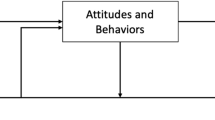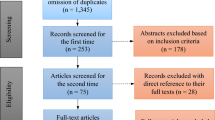Abstract
In this study, the Maker Competency Instrument (MCI) was developed to diagnose the level of Maker Competence of elementary and secondary students in South Korea. First, in this study, a draft of the test tool was adapted based on the Maker Competency Model developed as part of Yoon et al.’s research (2018). Then, two expert-level Delphi surveys examined the content validity of the MCI. To verify the construct’s validity, the exploratory factor analysis and the confirmatory factor analysis were conducted in two separate stages with the involvement of both teachers and professional Makers. As a result, it was confirmed by the MCI that 6 higher-order factors (Making mind, Making practice, collaboration, visual thinking, human-orientation, integrated thinking), 19 lower-order factors (observation, sense of challenge, interest in various areas, pleasure of the making process, understanding programming, understanding electricity, information searching, direct execution, understanding production tools, planning, hand knowledge, conflict management, communication, sharing, visual thinking and insight, humanity, user-oriented, analytical thinking, intuitive thinking), and 57 items were reasonable. From the outcome of this paper, it can be deduced that the MCI can be used from elementary to secondary school due to its proven reliability and validity.


Similar content being viewed by others
Data Availability
The data that support the findings of this study are available from the corresponding author upon request.
References
Ackermann, E. (2001). Piaget’s constructivism, papert’s constructionism: What’s the difference. Future of Learning Group Publication, 5(3), 438.
Anderson, C. (2012). Makers. The new industrial revolution. Crown Publishing Group.
Arnheim, R. (2004). Visual thinking (35th anniversary printing). Faber and Faber.
Bevan, B. (2017). The promise and the promises of making in science education. Studies in Science Education, 53(1), 75–103. https://doi.org/10.1080/03057267.2016.1275380
Blikstein, P., & Worsley, M. (2016). Children are not hackers: Building a culture of powerful ideas, deep learning, and equity in the maker movement. In K. Peppler, E. R. Halverson & Y. B. Kafai (Eds.), Makeology: Makerspaces as learning environments (pp. Vol. 1, pp. 64–79). New York: New York, NY: Routledge.
Blikstein, P. (2013). Digital fabrication and ‘making’ in education: The democratization of invention. FabLabs: Of Machines. Makers and Inventors, 4, 1–21.
Brahms, L. (2014). Making as a learning process: Identifying and supporting family learning in informal settings (Publication No. 3582510 [Doctoral dissertation, University of Pittsburgh]. Retrieved from ProQuest.
Browne, M. W., & Cudeck, R. (1993). Alternative ways of assessing model fit. Testing Structural Equation Models, Sage Focus Editions, 8(3), 136–162.
Bullock, S. M., & Sator, A. (2018). Developing a pedagogy of “Making” through collaborative self-study. Studying Teacher Education, 14(1), 56–70.
Bullock, S. M., & Sator, A. J. (2015). Maker pedagogy and science teacher education. Journal of the Canadian Association for Curriculum Studies, 13(1), 60–87.
Comrey, A. L., & Lee, H. B. (2013). A first course in factor analysis. Psychology press.
Costello, A. B., & Osborne, J. (2005). Best practices in exploratory factor analysis: Four recommendations for getting the most from your analysis. Practical Assessment, Research, and Evaluation, 10(1), 7.
Dougherty, D. (2012). The maker movement. Innovations: Technology, Governance, Globalization, 7(3), 11–14.
Dubois, D. D. (1993). Competency-based performance improvement: A strategy for organizational change. HRD Press.
Field, A. (2009). Discovering statistics using SPSS (3rd ed.). London.
Gutwill, J. P., Hido, N., & Sindorf, L. (2015). Research to practice: Observing learning in tinkering activities. Curator: the Museum Journal, 58(2), 151–168.
Hair, J. F., Black, W. C., Babin, B. J., Anderson, R. E., & Tatham, R. L. (2009). Análise multivariada de dados. Bookman Editora.
Halverson, E. R., & Sheridan, K. (2014). The maker movement in education. Harvard Educational Review, 84(4), 495–504.
Hinkin, T. R. (1998). A brief tutorial on the development of measures for use in survey questionnaires. Organizational Research Methods, 1(1), 104–121.
Hong, S. (2000). The criteria for selecting appropriate fit indices in structural equation modeling and their rationales. Korean Journal of Clinical Psychology, 19(1), 161–177.
Hu, L., & Bentler, P. M. (1999). Cutoff criteria for fit indexes in covariance structure analysis: Conventional criteria versus new alternatives. Structural Equation Modeling: A Multidisciplinary Journal, 6(1), 1–55.
Huang, T.-C., & Lin, C.-Y. (2017). From 3D modeling to 3D printing: Development of a differentiated spatial ability teaching model. Telematics and Informatics, 34(2), 604–613.
Kafai, Y., Fields, D., & Searle, K. (2014). Electronic textiles as disruptive designs: Supporting and challenging maker activities in schools. Harvard Educational Review, 84(4), 532–556.
Kafai, Y., Peppler, K., & Chapman, R. (2009). The computer clubhouse: Constructionism and creativity in youth communities. Technology, Education–Connections: ERIC.
Kapon, S., Schvartzer, M., & Peer, T. (2020). Forms of participation in an engineering maker-based inquiry in physics. Journal of Research in Science Teaching. https://doi.org/10.1002/tea.21654
Kim, K. (2010). Structural equation model analysis. Seoul: Hannarae.
Kim, Y. J. (2012). Development and validation of the leisure engagement scale in Korean. The Korean Journal of Physical Education, 51(5), 549–557.
Kishton, J. M., & Widaman, K. F. (1994). Unidimensional versus domain representative parceling of questionnaire items: An empirical example. Educational and Psychological Measurement, 54(3), 757–765.
Korea Foundation for the Advancement of Science and Creativity. (2015). Monthly scientific creative. April 2015 Issue. Seoul: KOFAC.
Krzystofiak, F., Cardy, R. L., & Newman, J. (1988). Implicit personality and performance appraisal: The influence of trait inferences on evaluations of behavior. Journal of Applied Psychology, 73(3), 515.
Lee, C. H., Seo, W. S., Gao, H. Y., Jo, D. H., & Seo, J. Y. (2016). Developing competencies for human resources in science and technology using the Delphi technique. Journal of Engineering Education Research, 16(2), 252–275.
Lee, Y. (2002). Understanding factor analysis. Seoul: Seogjeong.
Lin, Q., Yin, Y., Tang, X., Hadad, R., & Zhai, X. (2020). Assessing learning in technology-rich maker activities: A systematic review of empirical research. Computers & Education, 157, 103944.
Lotts, M. (2016). On the road, playing with Legos®, and learning about the library: The rutgers university art library lego playing station, Part Two. Journal of Library Administration, 56(5), 499–525.
Martin, R. (2010). Design thinking: Achieving insights via the “knowledge funnel.” Strategy & Leadership, 38(2), 37–41.
Martinez, S. L., & Stager, G. (2013). Invent to learn Torrance. Constructing modern knowledge press.
Marton, F., Fensham, P., & Chaiklin, S. (1994). A nobel’s eye view of scientific intuition: Discussions with the nobel prize-winners in physics, chemistry and medicine (1970–86). International Journal of Science Education, 16(4), 457–473.
National Research Council. (2007). Taking science to school: Learning and teaching science in grade K-8. National Academy Press.
National Research Council. (2009). Engineering in K-12 education. Washington, DC: National Academies Press. https://doi.org/10.17226/12635
National Research Council. (2012). A framework for K-12 science education: Practices, crosscutting concepts, and core ideas. The National Academies Press.
Norris, A. (2014). Make-her-spaces as hybrid places: Designing and resisting self-constructions in urban classrooms. Equity & Excellence in Education, 47(1), 63–77.
Papavlasopoulou, S., Giannakos, M. N., & Jaccheri, L. (2017). Empirical studies on the maker movement, a promising approach to learning: A literature review. Entertainment Computing, 18, 57–78.
Reise, S. P., Waller, N. G., & Comrey, A. L. (2000). Factor analysis and scale revision. Psychological Assessment, 12(3), 287–297.
Resnick, M., & Rosenbaum, E. (2013). Designing for tinkerability. In M. Honey & D. Kanter (Eds.), Design, make, play: Growing the next generation of STEM innovators (pp. 163–181). Routledge.
Resnick, M., Maloney, J., Monroy-Hernández, A., Rusk, N., Eastmond, E., Brennan, K., & Silverman, B. (2009). Scratch: Programming for all. Communications of the ACM, 52(11), 60–67.
Riggs, W. E. (1983). The Delphi technique: An experimental evaluation. Technological Forecasting and Social Change, 23(89), 94.
Santos, J. R. A. (1999). Cronbach’s alpha: A tool for assessing the reliability of scales. Journal of Extension, 37(2), 1–5.
Sass, D. A., & Smith, P. L. (2006). The effects of parceling unidimensional scales on structural parameter estimates in structural equation modeling. Structural Equation Modeling, 13(4), 566–586.
Schad, M., & Jones, W. M. (2020). The maker movement and education: A systematic review of the literature. Journal of Research on Technology in Education, 52(1), 65–78.
Spencer, L. M., & Spencer, S. M. (1993). Competence at work. John Wiley & Sons. Inc: P99–220.
Tak, J. K. (2007). Psychological testing: An understanding of development and evaluation method (2nd ed.). Hakjisa.
Thomas, A. (2014). Making makers: Kids, tools, and the future of innovation. Maker Media, Inc.
Vossoughi, S., Hooper, P. K., & Escudé, M. (2016). Making through the lens of culture and power: Toward transformative visions for educational equity. Harvard Educational Review, 86(2), 206–232.
Williams, B., Onsman, A., & Brown, T. (2010). Exploratory factor analysis: A five-step guide for novices. Australasian Journal of Paramedicine, 8(3), 1–13.
Worthington, R. L., & Whittaker, T. A. (2006). Scale development research: A content analysis and recommendations for best practices. The Counseling Psychologist, 34(6), 806–838.
Yang, B., Watkins, K. E., & Marsick, V. J. (2004). The construct of the learning organization: Dimensions, measurement, and validation. Human Resource Development Quarterly, 15(1), 31–55.
Yang, H., & Kang, S. (2016). Study on the development of a core competency model for the convergent gifted. The Korean Society for Gifted and Talented, 15, 93–119.
Yoon, J., Kim, K., & Kang, S. (2018). Developing maker competency model and exploring maker education plan in the field of elementary and secondary education. Journal of the Korean Association for Science Education, 38(5), 649–665.
Author information
Authors and Affiliations
Corresponding author
Ethics declarations
Ethical Approval
All procedures performed in studies involving human participants were in accordance with the ethical standards of the Human Research Ethics Committee (HREC) and with the 1964 Helsinki Declaration and its later amendments or comparable ethical standards.
Informed Consent
Informed consent was obtained from all individual participants included in the study.
Conflict of Interest
The authors declare no competing interests.
Additional information
Publisher's Note
Springer Nature remains neutral with regard to jurisdictional claims in published maps and institutional affiliations.
Supplementary Information
Below is the link to the electronic supplementary material.
Rights and permissions
Springer Nature or its licensor (e.g. a society or other partner) holds exclusive rights to this article under a publishing agreement with the author(s) or other rightsholder(s); author self-archiving of the accepted manuscript version of this article is solely governed by the terms of such publishing agreement and applicable law.
About this article
Cite this article
Yang, H., Yoon, J., Kim, K. et al. Maker Competency Instrument for Elementary and Secondary School Science. J Sci Educ Technol 32, 493–509 (2023). https://doi.org/10.1007/s10956-023-10037-0
Accepted:
Published:
Issue Date:
DOI: https://doi.org/10.1007/s10956-023-10037-0




